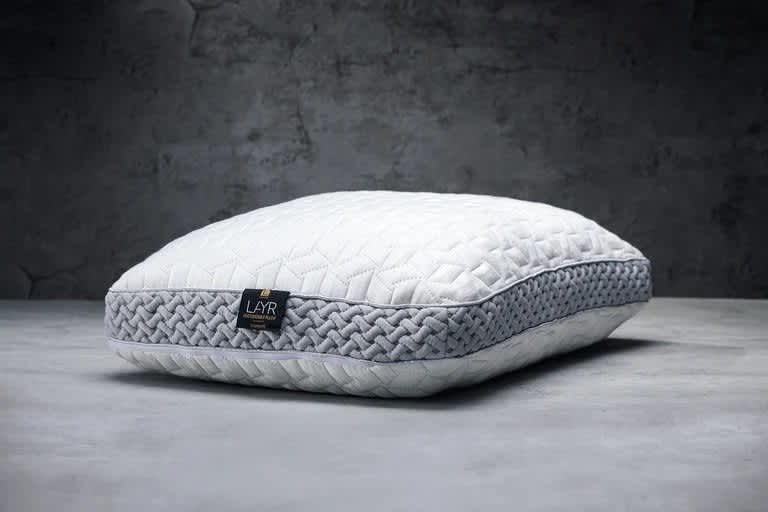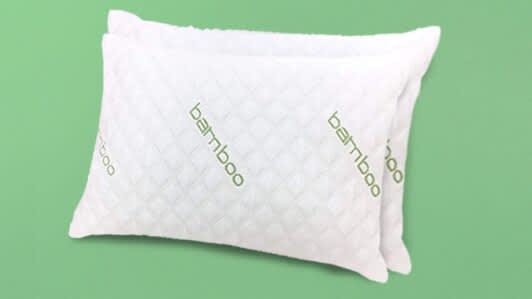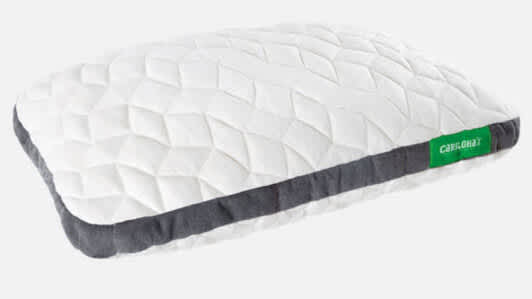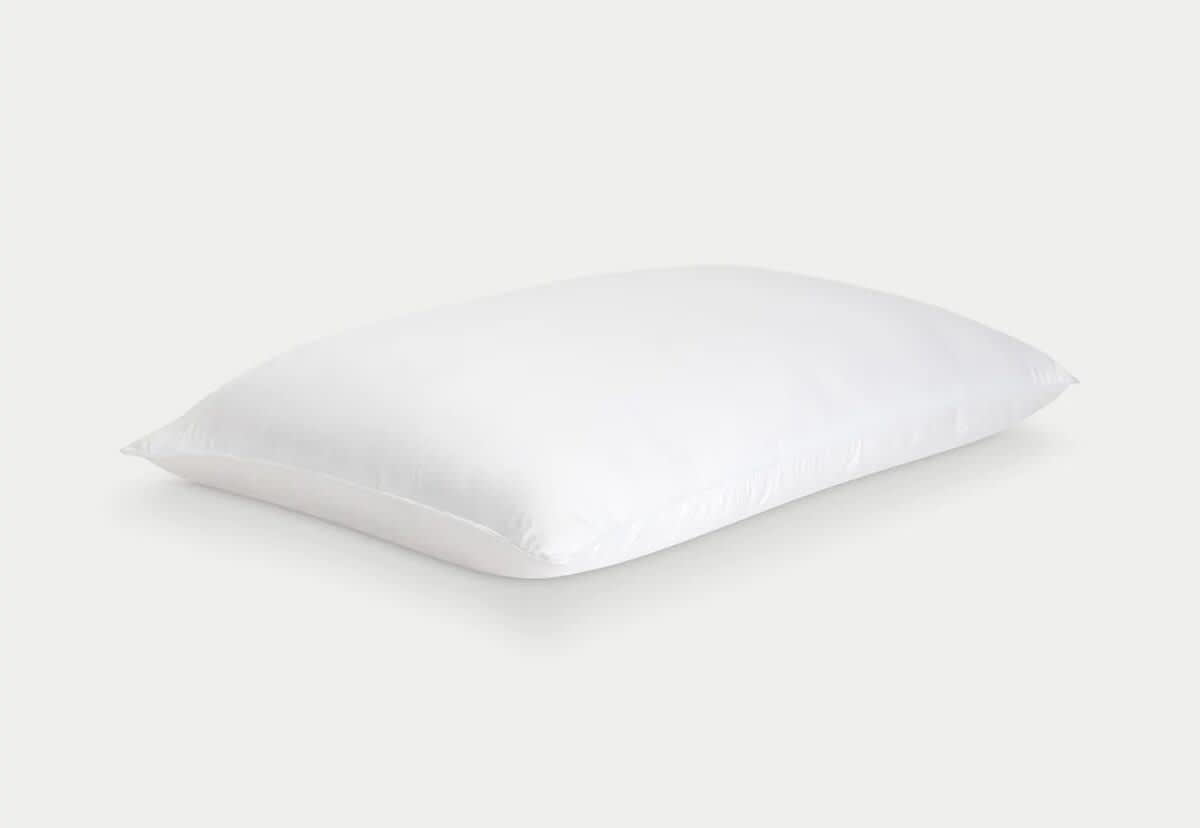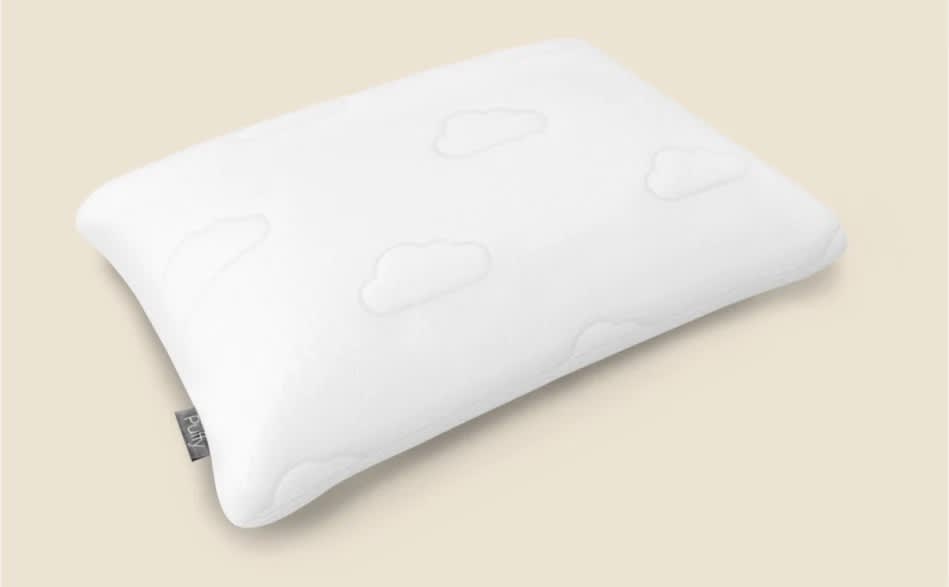On This Page
The Best Bamboo-Derived Pillows
Our Top Picks
-
Best Overall
Luxome LAYR Customizable Pillow -
Best Value
Sleepsia IK Bamboo Pillow -
Most Comfortable
Cariloha Flex Pillow -
Best Luxury
Cozy Earth Silk Pillow -
Best for Side Sleepers
Puffy Pillow
Best Overall
Highlights
Highlights
- Three types of fill for greater balance and adjustability
- Three inserts you can mix and match for the desired firmness and loft
- Gel-infused memory foam engineered for cooling
Ideal For
- Side, back, and stomach sleepers
- Those with changing needs or preferences
- Sleepers who prefer to customize their pillow
Full Details
Why We Like It
Best Value
Highlights
Highlights
- Shredded memory foam fill molds well without trapping heat
- Adjustable fill for customized comfort
- Washable cover
Ideal For
- Sleepers with changing position preferences
- Those prone to overheating
- Value seekers
Full Details
Why We Like It
Most Comfortable
Highlights
Highlights
- Easily remove or add fill to reach desired firmness
- Charcoal infusion engineered to wick moisture and resist odors
- 100-night trial period
Ideal For
- Side and back sleepers under 230 pounds
- Those with changing sleep styles
- Sleepers with sensitive skin
Full Details
Why We Like It
Best Luxury
Highlights
Highlights
- Constructed with mulberry silk and viscose from bamboo
- Breathable design for superior temperature regulation
- 100-night trial and 10-year limited warranty
Ideal For
- Hot sleepers
- Side and back sleepers
- Stomach sleepers under 230 pounds
Full Details
Why We Like It
Best for Side Sleepers
Highlights
Highlights
- Adjustable fill for customizable support
- 101-night trial and limited lifetime warranty
- Cool-to-the-touch cover
Ideal For
- Side and back sleepers under 230 pounds
- Those who run hot
- Individuals with changing sleep needs and preferences
Full Details
Why We Like It
How We Test Pillows
We test bamboo pillows against the same set of strict standards that we use for other pillow types, but we pay close attention to several factors that set bamboo pillows apart. In addition to firmness, conforming, and ease of cleaning, we also measure breathability. Many sleepers choose bamboo-derived materials for their cool feel. To determine how well a pillow regulates temperature, we use thermal sensors that measure heat retention and we try them ourselves too, taking notes on how warm or cool we think a pillow feels after use.
What Are Bamboo Pillows?
Bamboo pillows contain at least some materials derived from bamboo. Rayon, modal, viscose, and lyocell often use bamboo as a fiber source in their manufacturing processes, so you may see pillows that contain any of these materials marketed as bamboo.
Most bamboo pillows consist of a bamboo-derived cover and another type of fill, such as memory foam, latex, buckwheat hulls, or down alternative. Some bamboo pillows feature bamboo-derived materials in both the cover and fill, though this is significantly less common.
Bamboo pillows recently rose in popularity due to their many potential advantages, including their breathability, moisture control, and resistance to dust mites and other allergens.
Some eco-conscious shoppers also prefer bamboo pillows because the bamboo plant grows quickly, making it more sustainable. However, the process of turning bamboo into a fabric generally relies on chemicals, bringing its overall sustainability into question.
How Are Bamboo Pillows Made?
Bamboo pillows are made using the fast-growing grass plant, bamboo. While bamboo grows on all continents except Antarctica, it thrives in Southeast Asia due to the warm and moist climate. The plant needs little human intervention, requiring minimal fertilization, irrigation, and pesticides. Its ability to grow quickly and its ease of cultivation make it a sustainable crop for land restoration and an ideal plant for commercial use.
Before a bamboo pillow makes its way to your bed, the materials must first be harvested and processed. Farmers harvest the bamboo, which then goes through one of two processes to produce the necessary fibers. Mechanical processing requires machinery and a natural enzyme treatment to extract bamboo fibers. This process yields durable bamboo linen. Chemical processing is much more common. It utilizes chemicals to dissolve the cellulose in bamboo so that it can be reformed into fibers.
Mechanical processing is widely considered more eco-friendly but is rare.
Keep in mind that not all bamboo materials are created equally. If sustainability and eco-friendly practices are important to you, choose a brand that’s transparent about manufacturing and material sourcing.
Types of Bamboo Fabric
Manufacturing bamboo into fabric yields three main varieties, each with potential benefits and drawbacks.
- Bamboo Rayon: Rayon is the most common bamboo-derived fabric on the market. Crafted using chemical processing, bamboo rayon is an affordable semi-synthetic material often used in pillows. Common types of bamboo rayon include viscose and modal.
- Bamboo Lyocell: Chemical processing can also produce lyocell from bamboo, which is technically another type of rayon with a few distinctions. Lyocell production reuses chemicals in a closed-loop process, leading to less waste and enhanced sustainability. It also tends to be more moisture-wicking than other types of rayon.
- Bamboo Linen: Bamboo linen is lauded as the most environmentally friendly bamboo fabric option. Instead of chemical processing, it relies on a combination of mechanical crushing and a natural enzyme to produce the necessary fibers that are later spun into yarn. However, the manufacturing of bamboo linen requires more expensive processes, leading to a higher price tag. The resulting fabric also tends to be coarser and more prone to wrinkling.
Are Bamboo Pillows Good?
Bamboo pillows are a good option for hot sleepers and those with changing needs or preferences. Most bamboo pillows combine a bamboo-based fabric cover with varying fill materials, so there is a lot of variety in overall feel and performance.
Benefits of a Bamboo Pillow
Bamboo pillows have risen in popularity due to their many potential benefits. While the performance varies depending on the type of bamboo-derived material and the fill, most bamboo pillows on the market share a few similarities.
Breathability
Bamboo-derived threads tend to be extremely smooth, leaving gaps in the weave that air can flow through to help the pillow maintain a more neutral temperature. Many bamboo fabrics also actively wick moisture, keeping sleepers cooler and drier throughout the night.
To get that cooling, breathable feel that bamboo pillows are so famous for, choose a model that’s got a cooling fill. Materials like latex, buckwheat, and shredded memory foam generally have strong airflow.
Adjustability
Many bamboo pillows are adjustable, allowing sleepers to change the pillow’s loft or firmness by adding or removing fill. This makes them flexible enough to accommodate changing needs and preferences.
Sustainable and Natural Materials
Bamboo grows quickly with minimal human intervention, so raw bamboo is an eco-friendly resource. However, processing methods vary, so not all bamboo-derived fabrics are considered natural or sustainable.
Pillow Fill
Bamboo pillow fill varies. A few bamboo pillows contain bamboo fill, but most consist of other fill materials, such as memory foam, latex, buckwheat, or down alternative. The fill material plays a major role in the overall comfort and performance of the pillow.
Memory Foam
Memory foam fill is exceedingly common in bamboo pillows. This material may be solid or shredded, with solid options providing more consistent support and shredded excelling in moldability. Some memory foam pillows retain heat, though many now use technology designed for cooling. Memory foam models may also have an initial odor from manufacturing.
A bamboo pillow might use one of several types of memory foam.
- Traditional Memory Foam: Traditional memory foam pillows use a single block of memory foam, which provides support and pressure relief. However, these models are frequently less breathable and lack the moldability of more conventional pillow types.
- Open-Cell Memory Foam: Open-cell memory foam contains internal air pockets to promote air circulation. This material can be used in either solid or shredded memory foam fill.
- Gel Memory Foam: Gel memory foam includes a gel infusion designed to wick heat away from the sleeper’s body for improved temperature control. Shredded or solid memory foam pillows may use this material.
- Shredded Memory Foam: Shredded memory foam fill contains small pieces of memory foam. Because the pieces can move around, shredded memory foam pillows are traditionally more breathable and moldable.
Bamboo Fiber
Although bamboo fiber and bamboo fiber blend fill is not as common as memory foam, it offers its own array of potential benefits. Bamboo fill is usually highly breathable and moisture-wicking, making it a popular option for hot sleepers. It’s also less prone to manufacturing odors than memory foam.
Other Materials Used as Fill
Bamboo pillows can also use several other materials as fill.
- Latex: Bamboo pillows can contain solid or shredded latex fill. Both options perform well in our temperature readings. Solid latex pillows tend to be highly supportive with less hug than memory foam. Shredded latex pillows are traditionally softer, more moldable, and more breathable.
- Buckwheat: Buckwheat fill is an eco-friendly, supportive, and adjustable option. While buckwheat models are often ideal for maintaining good posture, they feel quite firm and may produce a rustling sound when you shift positions.
- Down Alternative: Down alternative fill usually uses polyester microfiber to mimic the plushness of down.
Choosing the Best Bamboo Pillow
Finding the right bamboo pillow for you is critical to comfort. The best pillow promotes spinal alignment and prevents neck and back pain. There’s a bamboo pillow model to accommodate virtually any sleep need or preference, but choosing the best pillow for you requires understanding your body type, sleep position, and habits.
- Sleeping Position: Sleeping position contributes to the ideal loft and firmness. Side sleepers typically need more support, so they often prefer a thicker pillow with a fill that doesn’t go flat, such as memory foam or latex. Back sleepers generally prefer a medium loft, and stomach sleepers usually need a thin pillow that doesn’t elevate the head excessively.
- Fill Type: The type of fill influences performance. Bamboo-derived fill, shredded latex or memory foam, down alternative, and buckwheat hull fill are typically breathable and moldable. Solid memory foam and latex retain their shape well for consistent support. Adjustable fill is the most flexible, allowing sleepers to customize the loft or firmness.
- Loft: Loft is how thick the pillow is. Usually, side sleepers need a high loft pillow to maintain good posture, back sleepers look for a medium loft, and stomach sleepers do well with a low loft. Many bamboo pillows have an adjustable loft with interior zippers that allow sleepers to add or remove interior fill according to their preferences.
- Support: The level of support is dependent upon the loft and type of fill. Materials that maintain their shape well generally offer more consistent support. Memory foam, latex, and buckwheat perform well in our tests. Down alternative and bamboo-derived fills vary more in their supportiveness, but you can often scrunch up pillows with these types of fill as needed.
- Firmness: The firmness level indicates the relative softness of the pillow. Many bamboo pillows are adjustable, allowing you to add or remove fill to change the feel. Firmness is largely subjective, so you may want to experiment with adjusting the fill and manipulating the shape until you find what feels right for you.
- Pressure Relief: Pressure relief also depends on the pillow’s fill. Memory foam-based pillows traditionally provide exceptional pressure relief by molding to the shape of the sleeper’s head and neck, redistributing their weight.
- Moldability: Moldable bamboo pillows are easy to manipulate into different shapes. Shredded memory foam or latex, bamboo-derived fiber, and down alternative fills are more moldable than solid memory foam or latex.
- Material Quality and Price: Although bamboo-based covers generally have long lifespans, a pillow’s fill often determines its overall durability. Any fill material may lose support over time. However, you may be able to restuff adjustable pillows when the fill degrades, extending their life expectancy.
Explore More Pillows
If you’re looking for a particular type of pillow, check out our other guides below.
More Pillows by Fill
- Best Buckwheat Pillows
- Best Down Alternative Pillows
- Best Down Pillows
- Best Feather Pillows
- Best Latex Pillows
- Best Memory Foam Pillows
- Best Polyester Pillows
Last Things to Know About Bamboo Pillows
When deciding whether a bamboo pillow is right for you, there are several additional aspects to consider, such as environmental impact, odor, and ease of cleaning.
Are Bamboo Pillows Eco-Friendly?
The environmental impact of bamboo pillows depends on the specific type of bamboo-derived material, so they may or may not be considered eco-friendly.
The bamboo plant is a natural and eco-friendly material due to its rapid growth, biodegradability, and minimal need for pesticides, fertilizer, and irrigation. However, the manufacturing processes used to create bamboo-derived fibers are generally not considered environmentally friendly due to their extensive use of chemicals. That said, bamboo linen uses a mechanical process to minimize the environmental impact, and lyocell relies on a closed-loop process to reduce waste.
When assessing a bamboo pillow’s sustainability, also consider the fill material. Check for certifications, such as CertiPUR-US and GREENGUARD Gold, which verify that the product meets certain health and environmental standards.
Do Bamboo Pillows Smell?
While bamboo-derived fabric does not typically have a discernible smell, some bamboo pillows may have an initial odor depending on their fill. Memory foam pillows usually have an off-gassing odor when they’re new, and natural latex pillows may have a slight rubbery smell.
Can You Wash a Bamboo Pillow?
Whether you can wash a bamboo pillow depends on its fill materials and construction, so follow the manufacturer’s directions. In many cases, bamboo-based covers are machine-washable.
With the exception of solid memory foam or latex models, most bamboo pillows should also be fluffed regularly to break up any clumps, reintroduce air, and redistribute the fill. Caring for your bamboo pillow in accordance with the manufacturer’s instructions can help preserve its lifespan.
